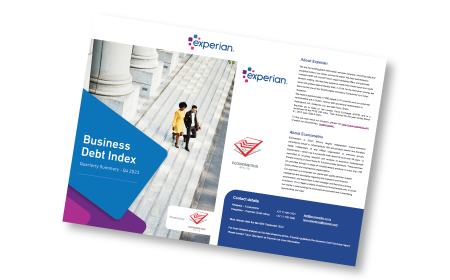The Experian Data Insights Check-In brings you key insights based on the Q4 2023 Business Debt Index.
The Experian Business Debt Index or BDI report is an indicator of the overall health of South African businesses as it measures the relative ability of businesses to pay their outstanding creditors on time.
This index incorporates bureau-sourced debtors’ payment profiles as well as a range of macroeconomic variables.
Our analytics experts have extracted key highlights to give you a good understanding of the current trends we’re seeing in the market.
Short and to the point, these key trends help you better understand the overall health of South African businesses.

Get the Q4 2023 BDI Report for a more detailed view of the overall health of South African businesses.
Download the BDI ReportListen to the Podcast
No time to read the article below? Listen to our podcast.
Experian Data Insights Check-In – Q4 2023 BDI Key Insights
8-minute read
The Experian Business Debt Index (BDI) combines Macro-economic metrics (like GDP) with Bureau metrics (in the form of Debt Age ratio’s) to provide a view on the prevalent business conditions in South Africa. The metric is demeaned and standardized, so that the BDI value is distributed around zero: A positive BDI signifies ‘Improving business conditions’, whilst a negative BDI indicates that business conditions are deteriorating. The Bureau metrics provide a view on the degree to which debtors are overdue agreed payment terms for invoiced amounts and are referred to as ‘Debt Age Ratio’s’. This data is provided by subscribers to the ‘Portfolio’ product here at Experian.
The 2023_Q4 BDI showed a marginal Q-o-Q improvement, moving up 0.15 in Q3 to 0.36 in Q4. The Q-o-Q improvement in BDI means that business conditions continue to be improving, and in fact are doing so at a slightly quicker rate. The main reason for the improved BDI was the slight improvement in GDP. Q-o-Q GDP grew by 0.1% in Q4, following from the negative growth of -0.2% in Q3.
The key drivers behind the slight growth in the GDP in Q4 revolves around relaxed levels of load shedding during this period. In addition, the improvement in logistical bottlenecks at South African ports also contributed to the stabilization of economic performance towards the end of 2023. Furthermore, the US economic growth (which is also considered in the calculation of the BDI) sustained an upward trend that surprised with its strength through 2023. This allowed for South Africa’s export performance to hold up slightly better than what might have been expected.
Improvement in BDI was further supported by improved debt age ratio’s – as calculated from our business bureau database here at Experian. More on that later.
From a sectoral perspective, most sectors saw an improvement in BDI. This was particularly true in the Services, Finance, Electricity and Transport sectors.
Significant deterioration in BDI was however observed in the Agriculture sector, which dropped from -0.84 to -1.19 in Q4. This weakening was brought on by the steep decline in the GDP for this sector.
Indeed, the Agri Y-o-Y GDP dropped for two consecutive quarters and is currently standing on -10.8% (looking at it Y-o-Y). This decline was driven by lower production numbers across various sectors, including field crops such as grain, sorghum, hay and wheat. There is no doubt that losses incurred due to fresh produce rotting at ports due to logistic challenges earlier in the year also had an influence here.
The season’s outlook for this sector is not too bright either. The projected maize harvest is expected to be over 10% lower than last season, and decreases is also expected for Soybean and sunflower harvest due to the prevailing El Nino conditions, that drive lower rainfall in the summer rainfall regions.
In spite of the relaxation in electricity load shedding towards the end of Q4, the overall level of loadshedding implemented by the national electricity provider, have been significantly more intense in 2023, than in the preceding 9 years. Towards the end of Q4 we saw a significant relaxation in load shedding level, was deemed to be one of the drivers of the latest marginal improvement of overall business conditions in the country.
In total, 2023 saw 290 days of load shedding in South Africa. For Q1 of 2024, this number was already at the 70 mark. With the national government elections coming in May this year, the electricity crisis is a key concern for citizens and political parties all put forward improved security of electricity supply as one of their priorities. The fact remains that unreliable electricity supply has put significant strain on the South African business environment and over a prolonged period, and that we see a significant move towards solar power by private entities.
The prevailing high interest rate continues to put pressure on businesses in South Africa from an affordability perspective.
The prime lending rate in South Africa has remained constant at 11.75% since April 2023, but many expect to see interest rates ease towards the latter part of 2024. The main driver behind the prime lending rate upcycle has been the CPI. At the current 11.75%, this is the highest that the Prime lending rate has been since 2009.
To unpack what we observe regarding Small and Medium Enterprises, we need to consider the Debt Age Ratio’s.
These ratio’s are the component of the BDI that is based on the payment profile data we hold and maintain on the bureau.
There are two such ratio’s calculated and incorporated into the BDI:
- 30-60 day debt age ratio and
- 60-90 day debt age ratio
These ratio’s are in fact metrics of the degree to which businesses are overdue owed amounts relative to the ‘within terms’ amount and can be indicative of the distress that businesses are facing in general, when it comes to honoring the payment terms that were committed to.
Improvement was seen both ratio’s, with the 30-60 debt age ratio decreasing from 20.69% to 20.4% and the 60-90 day ratio increasing from 6.7% to 5.6% this quarter. This was probably driven by the lower take-up of new credit by businesses – particularly considering the high interest rates.
When comparing the Debt Age Ratio’s of SME’s with that of the total market, SME’s we have seen SME’s continue to be in a more favourable debt age ratio situation than of total business (with regard to the 30-60 day ratio). For the 60-90 day ratio, have now returned to being better off than the bigger business counterparts – as was the case in Q2.
This is probably indicative of SME’s being particularly prudent when in comes to incurring new debt – especially considering the prevailing high interest rate currently at play – thinking twice before signing up for further financial commitments. It could also be indicative of the fact that the ease of load shedding levels seen in 2023 Q4 had an almost immediate positive effect on SME’s ability to honour existing debt commitments.
Looking forward to 2024, the anticipated interest rate decrease, increased investment in renewable energy projects and resulting GDP growth is expected to lead to marginal further improvement in the BDI in Q1.
There are clearly conspicuous risks in the economic outlook over the remainder of 2024 and beyond. The timing of the expected interest rate decrease remains open to debate, and there are also significant global as well as domestic concerns related to higher public debt levels and how debt servicing costs are eating away at the ability of governments to improve service delivery, given such spending constraints.
In South Africa’s case, the prospect of a general election fraught with uncertainty also acts as a deterrent to investment and overall business activity. Even so, it is conceivable that the electoral outcome might usher in an environment that is more conducive towards tackling the economy’s structural weaknesses and, in so doing, helps to launch a lift-off in the country’s economic performance.
For updates on the BDI and the general business conditions in South Africa, be sure to keep an eye out for our next instalment of the Experian BDI. If you are interested in our Business offerings in the Credit market, please reach out to us via our website: www.experian.co.za

Get the Q4 2023 BDI Report for a more detailed view of the overall health of South African businesses.
Download the BDI Report
Watch the Video
Watch our video in which Ans takes you through the various graphs that bring these data insights to life.

